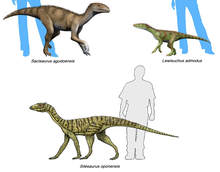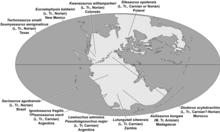Silesauridae
| Silesaurids Temporal range: ?Middle Triassic – Late Triassic, ? | |
|---|---|

| |
| Scientific classification | |
| Domain: | Eukaryota |
| Kingdom: | Animalia |
| Phylum: | Chordata |
| Clade: | Ornithodira |
| Clade: | Dinosauromorpha |
| Clade: | Dinosauriformes |
| Clade: | Dracohors |
| Clade: | Dinosauria (?) |
| Clade: | †Ornithischia (?) |
| Family: | †Silesauridae Langer et al., 2010 |
| Subgroups | |
| |
Silesauridae is an extinct family of Triassic dinosauriforms. It is most commonly considered to be a clade of non-dinosaur dinosauriforms, and the sister group of dinosaurs.[1][2][3][4][5] Some studies have instead suggested that most or all silesaurids comprised an early diverging clade or a paraphyletic grade within ornithischian dinosaurs.[6][7][8][9] Silesaurids have a consistent general body plan, with a fairly long neck and legs and possibly quadrupedal habits, but most silesaurids are heavily fragmentary nonetheless. Furthermore, they occupied a variety of ecological niches, with early silesaurids (such as Lewisuchus)[10] being carnivorous and later taxa (such as Kwanasaurus)[11] having adaptations for specialized herbivory. As indicated by the contents of referred coprolites, Silesaurus may have been insectivorous, feeding selectively on small beetles and other arthropods.[12]
Classification

Silesauridae is typically considered the sister group to Dinosauria. The group was named in 2010 by Max C. Langer et al. They defined it as a branch-based clade of all archosaurs closer to Silesaurus opolensis than to either Heterodontosaurus tucki or Marasuchus lilloensis.[13] At around the same time, Sterling J. Nesbitt et al. (2010) independently named Silesauridae as a node-based clade consisting of Lewisuchus, Silesaurus, their last common ancestor and all their descendants.[1] Currently, both definitions encompass the same group of animals. Nesbitt et al. noted that the earlier definition by Langer et al. did not include a diagnosis, and so was not sufficient to create a ranked family-level name according to the ICZN. Therefore, the family Silesauridae is attributed to Nesbitt et al. (2010) while the clade Silesauridae is attributed to Langer et al. (2010).[3]
Phylogenetic studies originally recovered Silesauridae as a clade sister to Dinosauria, including a variety of Triassic taxa related to Silesaurus. Sometimes the genera are recovered as successive sister taxa to dinosaurs rather than a clade, but often a group is recovered as possibly quadrupedal herbivorous taxa.[13]
A large phylogenetic analysis of early dinosaurs and dinosauromorphs carried out by Matthew Baron, David Norman and Paul Barrett (2017) and published in the journal Nature recovered Silesauridae as a monophyletic sister group to Dinosauria. The study also recovered the taxon Agnosphitys within the clade Silesauridae, close to Lewisuchus and its synonymous taxon Pseudolagosuchus.[4] A 2022 study by Norman and colleagues instead found silesaurs to be a paraphyletic group on the branch leading to traditional Ornithischia. The cladogram below is based on their study.[14] This topology is almost identical to the one recovered by Müller & Garcia (2020)[9] in their first iteration of the same dataset. When found as a grade of ornithischians, Amanasaurus, Ignotosaurus and Silesaurus have still been recovered as a clade, which makes them the only members of Silesauridae under those results.[15]
The inclusion of Pisanosaurus by some studies would mean that, according to ICZN rules, the name of the family should be the older name, Pisanosauridae, which was erected by Rodolfo Casamiquela in 1967.
While Sulcimentisauria is used for all ornithischians by some authors, the original intention of the clade was as a subdivision within Silesauridae, the new use being significantly different from its original application. A solution to this could be to restrict Sulcimentisauria to only apply to a subclade of Silesauridae, where it would no longer be applied along the ornithischian stem as a clade.[16]
Martz & Small, 2019[11]
Müller & Garcia, 2023[15]
| Dinosauriformes |
| |||||||||||||
References
- ^ a b Nesbitt, S.J.; Sidor, C.A.; Irmis, R.B.; Angielczyk, K.D.; Smith, R.M.H.; Tsuji, L.M.A. (2010). "Ecologically distinct dinosaurian sister group shows early diversification of Ornithodira". Nature. 464 (7285): 95–98. Bibcode:2010Natur.464...95N. doi:10.1038/nature08718. PMID 20203608. S2CID 4344048.
- ^ Nesbitt, S.J. (2011). "The early evolution of archosaurs: relationships and the origin of major clades". Bulletin of the American Museum of Natural History. 352: 1–292. doi:10.1206/352.1. hdl:2246/6112. S2CID 83493714.
- ^ a b Kammerer, C. F.; Nesbitt, S. J.; Shubin, N. H. (2012). "The First Silesaurid Dinosauriform from the Late Triassic of Morocco" (PDF). Acta Palaeontologica Polonica. 57 (2): 277. doi:10.4202/app.2011.0015.
- ^ a b Baron, M.G.; Norman, D.B.; Barrett, P.M. (2017). "A new hypothesis of dinosaur relationships and early dinosaur evolution". Nature. 543 (7646): 501–506. Bibcode:2017Natur.543..501B. doi:10.1038/nature21700. PMID 28332513. S2CID 205254710.
- ^ Andrea Cau (2018). "The assembly of the avian body plan: a 160-million-year long process" (PDF). Bollettino della Società Paleontologica Italiana. 57 (1): 1–25. doi:10.4435/BSPI.2018.01 (inactive 20 November 2024).
{{cite journal}}: CS1 maint: DOI inactive as of November 2024 (link) - ^ Ferigolo, Jorge; Langer, Max C. (1 January 2007). "A Late Triassic dinosauriform from south Brazil and the origin of the ornithischian predentary bone". Historical Biology. 19 (1): 23–33. doi:10.1080/08912960600845767. ISSN 0891-2963. S2CID 85819339.
- ^ Langer, Max C.; Ferigolo, Jorge (1 January 2013). "The Late Triassic dinosauromorph Sacisaurus agudoensis (Caturrita Formation; Rio Grande do Sul, Brazil): anatomy and affinities". Geological Society, London, Special Publications. 379 (1): 353–392. Bibcode:2013GSLSP.379..353L. doi:10.1144/SP379.16. ISSN 0305-8719. S2CID 131414332.
- ^ Cabreira, S.F.; Kellner, A.W.A.; Dias-da-Silva, S.; da Silva, L.R.; Bronzati, M.; de Almeida Marsola, J.C.; Müller, R.T.; de Souza Bittencourt, J.; Batista, B.J.; Raugust, T.; Carrilho, R.; Brodt, A.; Langer, M.C. (2016). "A Unique Late Triassic Dinosauromorph Assemblage Reveals Dinosaur Ancestral Anatomy and Diet". Current Biology. 26 (22): 3090–3095. doi:10.1016/j.cub.2016.09.040. PMID 27839975.
- ^ a b Müller, Rodrigo Temp; Garcia, Maurício Silva (26 August 2020). "A paraphyletic 'Silesauridae' as an alternative hypothesis for the initial radiation of ornithischian dinosaurs". Biology Letters. 16 (8): 20200417. doi:10.1098/rsbl.2020.0417. PMC 7480155. PMID 32842895.
- ^ Ezcurra, Martín D.; Nesbitt, Sterling J.; Fiorelli, Lucas E.; Desojo, Julia B. (24 August 2019). "New specimen sheds light on the anatomy and taxonomy of the early Late Triassic dinosauriforms from the Chañares Formation, NW Argentina". The Anatomical Record. 303 (5): 1393–1438. doi:10.1002/ar.24243. hdl:11336/129047. ISSN 1932-8494. PMID 31444989.
- ^ a b Martz, J.W.; Small, B.J. (2019). "Non-dinosaurian dinosauromorphs from the Chinle Formation (Upper Triassic) of the Eagle Basin, northern Colorado: Dromomeron romeri (Lagerpetidae) and a new taxon, Kwanasaurus williamparkeri (Silesauridae)". PeerJ. 7: e7551. doi:10.7717/peerj.7551. PMC 6730537. PMID 31534843.
- ^ Martin Qvarnström; Joel Vikberg Wernström; Rafał Piechowski; Mateusz Tałanda; Per E. Ahlberg; Grzegorz Niedźwiedzki (2019). "Beetle-bearing coprolites possibly reveal the diet of a Late Triassic dinosauriform". Royal Society Open Science. 6 (3): Article ID 181042. Bibcode:2019RSOS....681042Q. doi:10.1098/rsos.181042. PMC 6458417. PMID 31031991.
- ^ a b Langer, M.C.; Ezcurra, M.D.; Bittencourt, J.S.; Novas, F.E. (2010). "The origin and early evolution of dinosaurs". Biological Reviews. 85 (1): 55–110. doi:10.1111/j.1469-185X.2009.00094.x. hdl:11336/103412. PMID 19895605. S2CID 34530296.
- ^ Norman, David B; Baron, Matthew G; Garcia, Mauricio S; Müller, Rodrigo Temp (2022). "Taxonomic, palaeobiological and evolutionary implications of a phylogenetic hypothesis for Ornithischia (Archosauria: Dinosauria)". Zoological Journal of the Linnean Society. 196 (4): 1273–1309. doi:10.1093/zoolinnean/zlac062.
- ^ a b Müller, R.T.; Garcia, M.S. (2023). "A new silesaurid from Carnian beds of Brazil flls a gap in the radiation of avian line archosaurs". Scientific Reports. 13 (1): 4981. doi:10.1038/s41598-023-32057-x. PMC 10090097. PMID 37041170.
- ^ Madzia, D.; Arbour, V.M.; Boyd, C.A.; Farke, A.A.; Cruzado-Caballero, P.; Evans, D.C. (2021). "The phylogenetic nomenclature of ornithischian dinosaurs". PeerJ. 9: e12362. doi:10.7717/peerj.12362. PMC 8667728. PMID 34966571.
External links
- Silesauridae in the Paleobiology Database



